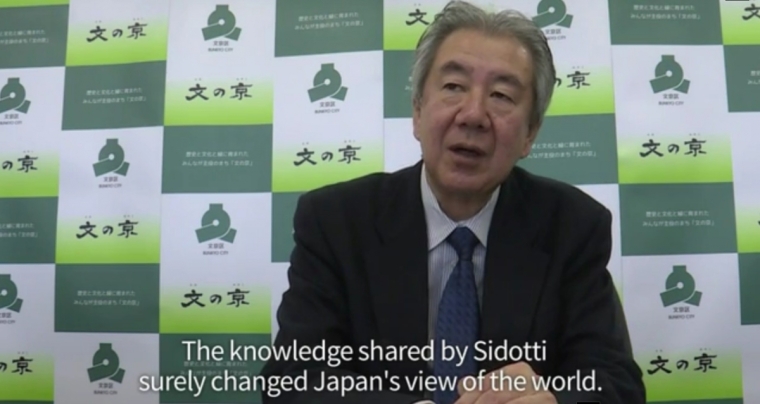Bones found in Tokyo believed to be of Italian missionary who helped change Japan's view of the world

A set of bones found in Japan is believed to have belonged to an Italian missionary who came to the country in the 1700s, at a time when Christianity was banned. He had been recognized as someone who helped change how Japan viewed the world.
According to Agence France-Presse, three sets of bones were found in July 2014 at a construction site in Tokyo, formerly called Edo, where the prison Kirishitan Yashiki or Christian Mansion was located. For six months, researchers at the National Museum of Nature and Science pieced the bone fragments together, and the museum's chief of anthropology Kenichi Shinoda conducted a DNA analysis. He discovered that one set was of the same genetic type as present-day Italians.
Since historical records show that only two Italian missionaries were held at the prison -- and one of them, Giuseppe Chiara, died at 84 and was cremated -- it was then concluded that the one found likely belonged to then-47-year-old Giovanni Battista Sidotti.
The report says that Japan was in national seclusion from 1639 and banned foreign religion because it was deemed as a threat to national identity, but Sidotti disguised himself as a samurai in 1708 in order to enter the country. He was captured, imprisoned, and interrogated by Arai Hakuseki, Japan's top Confucian scholar.
The missionary earned the respect of the scholar because of his knowledge in different matters, including global affairs, geography, and languages. Arai reportedly wanted to help Sidotti, but the latter was put in the dungeon for allegedly baptizing the couple who attended to his needs. The two sets of bones found with the Italian's could have belonged to the couple.

While no one really knew how Sidotti died, there were later accounts that he was treated with respect even though he refused to give up his faith. Following the discovery of the bones, researchers believe that he was accorded what could have been a burial "in a Christian way."
"His body was laid flat in a casket, a luxurious one as far as I can tell by the brackets," said lead researcher Akio Tanigawa, professor of archaeology at Tokyo's Waseda University. "People did not bury human bodies like this."
In 18th century Edo, the traditional way of burial was to arrange remains in a sitting position and place them in a small tub, just like one found next to the casket.
Sidotti has been given credit for helping shape Japan's view of the world. Arai, who was an adviser to Japan's rulers, wrote a study on the Western world, and he cited the Italian missionary as his primary source.
"The knowledge shared by Sidotti surely changed Japan's view of the world," said Tanigawa.
The Kirishitan Yashiki prison no longer stands -- in its place is parking lot of an upscale condominium -- but a stone marker had been placed to commemorate the historical spot.
 Christians don't have to affirm transgenderism, but they can’t express that view at work: tribunal
Christians don't have to affirm transgenderism, but they can’t express that view at work: tribunal Archaeology discovery: Medieval Christian prayer beads found on Holy Island
Archaeology discovery: Medieval Christian prayer beads found on Holy Island Presbyterian Church in America votes to leave National Association of Evangelicals
Presbyterian Church in America votes to leave National Association of Evangelicals Over 50 killed in 'vile and satanic' attack at Nigerian church on Pentecost Sunday
Over 50 killed in 'vile and satanic' attack at Nigerian church on Pentecost Sunday Ukrainian Orthodox Church severs ties with Moscow over Patriarch Kirill's support for Putin's war
Ukrainian Orthodox Church severs ties with Moscow over Patriarch Kirill's support for Putin's war Islamic State kills 20 Nigerian Christians as revenge for US airstrike
Islamic State kills 20 Nigerian Christians as revenge for US airstrike Man who served 33 years in prison for murder leads inmates to Christ
Man who served 33 years in prison for murder leads inmates to Christ


 Nigerian student beaten to death, body burned over ‘blasphemous’ WhatsApp message
Nigerian student beaten to death, body burned over ‘blasphemous’ WhatsApp message 'A new low': World reacts after Hong Kong arrests 90-year-old Cardinal Joseph Zen
'A new low': World reacts after Hong Kong arrests 90-year-old Cardinal Joseph Zen Iran sentences Christian man to 10 years in prison for hosting house church worship gathering
Iran sentences Christian man to 10 years in prison for hosting house church worship gathering French Guyana: Pastor shot dead, church set on fire after meeting delegation of Evangelicals
French Guyana: Pastor shot dead, church set on fire after meeting delegation of Evangelicals ‘Talking Jesus’ report finds only 6% of UK adults identify as practicing Christians
‘Talking Jesus’ report finds only 6% of UK adults identify as practicing Christians Mission Eurasia ministry center blown up in Ukraine, hundreds of Bibles destroyed: 'God will provide'
Mission Eurasia ministry center blown up in Ukraine, hundreds of Bibles destroyed: 'God will provide' Church holds service for first time after ISIS desecrated it 8 years ago
Church holds service for first time after ISIS desecrated it 8 years ago Burger King apologizes for 'offensive campaign' using Jesus' words at the Last Supper
Burger King apologizes for 'offensive campaign' using Jesus' words at the Last Supper Uganda: Muslims abduct teacher, burn him inside mosque for praying in Christ’s name
Uganda: Muslims abduct teacher, burn him inside mosque for praying in Christ’s name